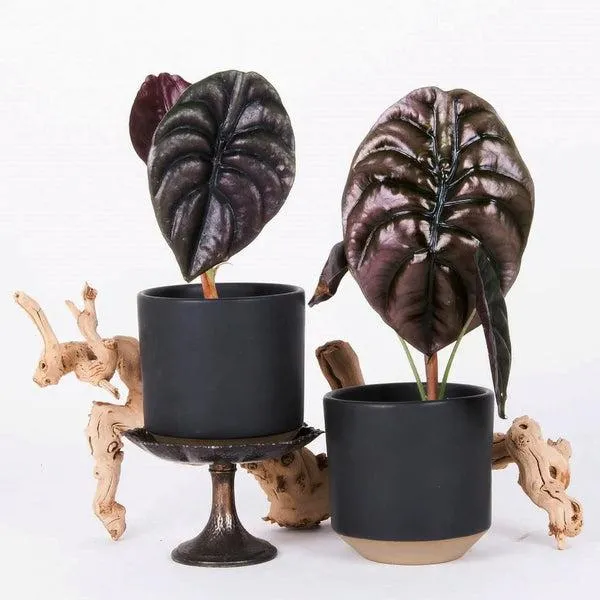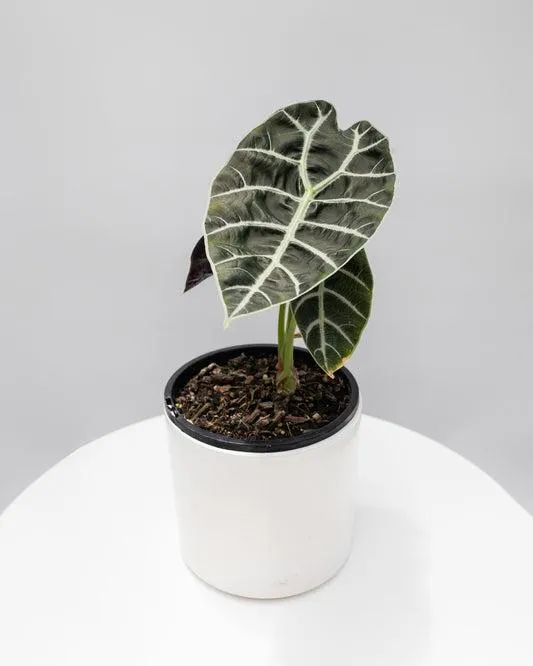Your Complete Guide to Growing Alocasia Melano
The Alocasia Melano is one of the coolest houseplants you can have. With its uniquely patterned leaves and tropical appearance, it’s basically guaranteed to spruce up any space. But growing this beauty successfully takes some know-how.
Getting to Know the Alocasia Melano
- Origin: The Alocasia Melano is native to tropical regions of Southeast Asia and parts of Australia.
- Care Level: Considered intermediate care – it has more specific needs than a pothos but isn’t as fussy as an orchid.
- Light Needs: Prefers bright, indirect sunlight. Direct sun may cause leaves to burn.
- Water Needs: Keep soil slightly moist but not soggy. Allow top inch to dry between waterings.
- Humidity: Thrives in ambient humidity 50% or higher. A pebble tray or humidifier helps in dry homes.
- Soil: Well-draining, organic potting mix. Keep moist but not wet.
- Fertilizer: Apply liquid houseplant fertilizer monthly during spring and summer.
- Temperature: Grow between 65-80°F. Won’t tolerate freezing.
From my experience, the Melano can be pretty finicky about light and moisture levels. Sort of like that friend who just can’t seem to deal with a subpar coffee – it knows what it wants! With some trial and error, you’ll get the hang of it.
Starting with a New Plant
When shopping for your first Melano, look for healthy, blemish-free leaves with new growth. Crowded or etiolated plants won’t transition well. Pot size should match the root ball. Opt for nursery pots over decorative ones, which can restrict growth.
Pot it in a well-draining mix and water thoroughly. Then find the perfect spot, maybe near an east-facing window or under grow lights if your home is kinda dim. Check soil moisture daily until you learn its needs. Alocasias are prone to root rot, so never let the soil fully dry out or stay soggy for long.
Kind of a fine line, if you ask me! One thing’s for sure – accept the plant’s drama, and staying on its good side becomes easier the more time you spend together.
Propagating New Plants
Once established, Alocasias can be propagated through root cuttings or separating offsets. Here’s the sitch:
Root Cuttings:
Carefully remove a section with buds or roots from the mother plant. Place the cutting in warm, moist propagator soil or perlite. Mist daily until new growth appears, usually 4-6 weeks.
Offset Division:
When a new corm forms attached to the mother, separate it byslicing below the new growth with a clean knife. Allow cut surfaces to callus before potting. Water sparingly until new leaves emerge.

Both methods have worked for me, though offsets seem less stressful on the original plant. Replant offsets 6-8 inches apart once established. With ample humidity and care, you’ll end up with a whole colony before you know it!
Care Tips for a Thriving Melano
Here are some additional pointers I’ve picked up along the way:
- Rotate plants monthly to encourage even growth patterns.
- Wipe leaves with a damp cloth to remove dust. Don’t submerge foliage in water.
- Repot annually in spring using a pot just 1-2 inches larger. Overpotting stunts growth.
- Support tall stems with bamboo stakes if leaves are heavy or floppy.
- Watch for pests like spider mites or mealybugs. Treat promptly with neem oil or insecticidal soap.
- Bring indoors before first fall frost. Acclimate gradually to lower winter light levels.
- Trim off yellowing or crispy leaves as needed.
- Fertilize less in winter when growth slows.
With a little TLC, your Melano can thrive for years to come. It may take a few tries to get the rhythm right, but don’t give up! That’s just part of the adventure, if you ask me.
Dealing with Common Issues
Like any indoor plant, Melanos sometimes face problems. Here are a few that commonly crop up and how to remedy them:
Brown Leaf Tips or Edges:
Could be too much or too little water, drying air, or mineral deposits on leaves blocking humidity absorption. Flush pots, group with other plants for more humidity, mist leaves, and monitor watering.
Yellowing or Wilting Leaves:
Usually a sign of overwatering. Check for soggy soil and improve drainage. Cut back water until it’s damp rather than soaked.
Drooping Leaves:
Can mean underwatering or low humidity. Check soil moisture, water thoroughly, and use a humidifier or pebble tray if needed. Prop up stems until perked up.
Powdery Mildew:
Fungal infection appearing as a white or gray powder. Isolate plant, wipe leaves with diluted milk or 3% hydrogen peroxide, improve air circulation and water properly to avoid recurrence.

With some trial and tons of error, you’ll get the hang of keeping your Melano happy and healthy. Just don’t be too hard on yourself if you mess up now and then – we all do!
Creating the Perfect Environment
Though fairly adaptable, Melanos really appreciate tropical conditions. Here are some ways to up the humidity and quality of care:
– Group plants together for a miniature jungle effect. Their collective transpiration raises ambient moisture.
– Use a pebble tray by placing rocks in a basin of water beneath plants. Evaporating water hydrates air. Empty and refill tray daily.
– A cool mist or ultrasonic humidifier set on a moisture loving plant’s microclimate prevents dehydration. Refill often.
– Consider an enclosed IKEA terrarium or custom-built greenhouse cabinet to trap humidity. Requires minimal maintenance.
– Build or purchase a heat mat for root zone warmth. Helps offset lower winter temperatures in dry heated homes.
– Supplement lighting with grow lights suspended above plants for six to eight hours daily in low light seasons.

With enough love, an Alocasia thrives like it’s in the tropics. Does that seem like too much work? Basically, just give it tropical vibes as you can – the drama queen will appreciate your effort, trust me!
Dealing with Pests
Unfortunately, popular houseplants sometimes attract bugs. A few critters cause big problems for Melanos. Here’s how I turf the troublemakers:
Spider mites leave webbing on leaves and stems. I spray leaves daily with water to dislodge pests before trying neem oil or insecticidal soap, repeating weekly until clear. These tiny vampires are relentless!
Mealybugs appear as fluffy white dots secreting honeydew. I dab each one with rubbing alcohol on a cotton ball to zap them quickly. Then spray remaining foliage to catch any hidden bugs. Yuck!
Scale hides under armor-like shells on stems. I scrape them off with a cotton ball dipped in isopropyl alcohol taking care not to damage new growth beneath. Even one scale can cause an infestation, so stay vigilant!
Prevention is key – clean up leaf litter, quarantine new plants, and encourage beneficial insects. A little neem oil weekly also acts as a natural deterrent. Phew, the things we do for our plant BFFs!
Alocasia Melanos and You
So in summary, Alocasia Melanos make awesome houseplants – as long as you give them conditions close to their tropical homeland. With bright, indirect light; consistently moist soil; high humidity; and occasional fertilizing or dividing, your Melano will stick around creating drama and beauty for seasons to come.
Does all this seem like a lot? Sure, they’re a bit particular. But aren’t we all! Plus, caring for exotic foliage teaches patience and expands your green thumb. The joy of a thriving, unusual plant repays any extra effort. So go ahead – treat yourself to an Alocasia Melano. I promise it’ll become one of your fave indoor jungle kids. Let me know if you have any other questions!

Common Facts about Alocasia Melano
| Characteristic | Details |
|---|---|
| Botanical Name | Alocasia melano |
| Hardiness Zones | 9-11 |
| Growth Rate | Moderate |
| Light Requirements | Bright indirect light |
| Water Needs | Keep soil moist; let dry slightly between waterings |
| Humidity Preferences | Prefers humid conditions above 50% |
| Foliage Color | Velvety dark purple blades |
| Mature Size | Up to 3 feet tall and wide |
FAQ
- What climate does the alocasia melano plant like? Basically, alocasia melano prefers warm, humid conditions. It grows best in temperatures around 70-80°F. Too much heat or cold can harm the plant.
- How often should I water my alocasia? You’ll want to water when the top inch or two of soil is dry. Kind of pay attention to when the leaves start looking a little sad. Too much or too little water will make it unhappy. I usually water mine about once a week.
- What kind of light does it need? Alocasias require lots of bright, indirect light. Direct sunlight can burn their leaves. So aim to keep them in a spot with morning sun, perhaps, but shade in the afternoon. They do not thrive in low light conditions.
- How do I care for the leaves? The leaves on alocasia are pretty amazing but also need TLC. Wipe them down weekly with a damp cloth to remove dust. You could also use a humidifier nearby to keep the humidity levels up, so the leaves stay in stunning shape. Question: does anyone else find wipe down day oddly satisfying?
Potting and soil
Alocasias have massive root systems, so choosing the right pot is important. Select something with good drainage. Perhaps a terra cotta pot would allow excess water to evaporate. As for soil, use a well-draining potting mix. You could add some perlite or vermiculite to further improve drainage. On the other hand, if the soil stays too wet it can cause root rot, which is no fun at all.
Pruning
Over time, older leaves on an alocasia may begin to yellow and die off. You can cut these leaves back to the soil. This encourages new growth. It’s sort of like a haircut that makes your plant look fresh and revitalized! However, be careful not to remove too many leaves at once, as the plant needs them to photosynthesize. Alocasia reproduction works in strange ways too, with corms and offsets rather than seeds. I guess nature finds fun and quirky methods for plants to multiply.
Pests
Most houseplants are at risk for pests like spider mites, scale or mealybugs. Keep a close eye on your alocasia and check thoroughly under leaves. At the first sign of an infestation, isolate the plant and treat it as needed. Natural remedies may be worth trying first before reaching for chemicals. It’s also wise to check any new plants for hitchhiking guests before introducing them to your collection. Do your peers ever experience pest problems? What have you found works best for treatment?
